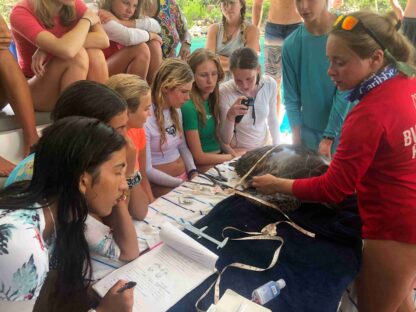Sea Turtle Predators: Understanding the Threats to Sea Turtles

Sea turtles face many threats throughout their lives, from the moment they hatch on the beach to their adult years in the ocean. In this article, you’ll learn about the predators that target these incredible creatures and why understanding these dangers is crucial for their survival. Find out how you can play a part in sea turtle conservation by joining Sail Caribbean’s marine biology summer camp!
Natural Predators of Sea Turtle Hatchlings
Sea turtle hatchlings face many predators on land and in the water. Due to their vulnerable nature, hatchlings face a lot of danger from turtle predators. They first hatch on land, typically on beaches, and then make their way to the water. On land, animals like fire ants, crabs, birds, raccoons, and foxes track sea turtle eggs and hatchlings. Crabs, like ghost crabs, tend to dig up nesting areas where the eggs lie. Furthermore, birds spot the hatchlings as they cross the beaches towards the ocean. Small mammals like raccoons and foxes either dig up the nests or prey on juvenile sea turtles on the beach. Moreover, the sea turtle hatchlings then have to face predators like fish, sharks, and other marine animals once they reach the water. Sadly, mostly because of these predators, only 1 in 100,000 hatchlings make it to adulthood.
Natural Predators of Adult Sea Turtles
While adult turtles are less frequently preyed upon, they are still at risk from marine predators. Because of the large risks sea turtle hatchlings face, there are fewer adult sea turtles. However, they still face threats in the ocean. Once adult female sea turtles travel to beaches to nest, large land predators like jaguars, wild boars, alligators, and crocodiles pose a large threat. Leatherback sea turtle threats tend to be mostly killer whales, while tiger sharks are green sea turtle predators.

The Impact of Human Activity on Sea Turtle Populations
Sea turtles are greatly impacted by human activity throughout the world. Habitat destruction, poaching, and pollution are the biggest threats to sea turtle populations. Climate change and marine pollution also extremely affect the lives of sea turtles. Human activity exacerbates climate change, which can affect nesting sites and the sex ratio of hatchlings. Conservation efforts to halt ocean pollution and other harmful human activity are crucial to prevent the extinction of these majestic creatures.

Habitat Destruction and Poaching
Destruction to their habitats takes place on both land and sea. For instance, coastal building and development and beach traffic inhibit female turtles from nesting in protected areas. In the sea, boats and swimmers can disrupt seagrass beds, which are a large food source for sea turtles. Poaching takes place when fishers capture sea turtles for their shells, meat, and other resources. Furthermore, people will partake in illegal egg harvesting where they take eggs to sell.
Marine Pollution and Debris
Pollution litters the oceans all over the world, hindering the existence of sea turtles in terms of their health, reproductive processes, and survival. They often mistake things like plastics and discarded fishing nets for food, which creates blockages in their digestive systems and causes malnutrition. Fishing nets can also entangle the sea turtles, capturing them and creating injuries, making it harder for them to swim, get away from predators, and forage.

How Sail Caribbean’s Marine Biology Summer Camp Helps
Sail Caribbean Marine Biology Summer Camp focuses on multiple topics of marine biology. One major part of their Sierra Program is to learn about and help the efforts of sea turtle conservation. We work with the BVI Association of Reef Keepers (ARK) in their extensive research and fieldwork to protect the lives of sea turtles in the British Virgin Islands. Students learn about sea grass beds and their importance, as well as how to extract samples to check on their health. This makes sure that the sea grass, one major food source for sea turtles, is safe for them to ingest. The students also go on excursions to tag live sea turtles. Tagging sea turtles provides researchers and conservationists with data on their behaviors, environments, and health. Students at Sail Caribbean’s marine biology summer camp will directly contribute to the protection of sea turtles during their stay.

Join the Conservation Effort at Sail Caribbean
There are many different organizations in the British Virgin Islands that Sail Caribbean Summer Camp has the fortunate opportunity to work with. Not only are the students participating in marine biology lessons, but they are also immersed in the environment during the experience.
Students live on catamarans for two to three weeks and spend time on anchor, in mooring fields, and on the dock. As soon as they jump in the water with snorkel masks on, they are opened to the world underneath the surface. Spotting eagle rays and dolphins off the bow, catching sea turtles coming up for air or feeding on seagrass under the boats, and identifying fish they have never seen before are just a few ways Sail Caribbean students get acquainted with this unique marine environment.
When they are participating in carefully curated lessons, students work alongside marine biologists in the area and contribute to their conservation efforts. Sea turtles become friendly neighbors to our crews. At Sail Caribbean, it is not just about learning about marine biology but also directly impacting this environment and the marine animals that they come to love.


Conclusion
Sea turtles face numerous natural predators and human-induced threats, but through education and action, we can help protect them. By joining Sail Caribbean’s marine biology summer camp, you’ll gain hands-on experience in sea turtle conservation and make a real impact in the fight to save these incredible creatures. Apply now to become a part of the next generation of sea turtle protectors!
